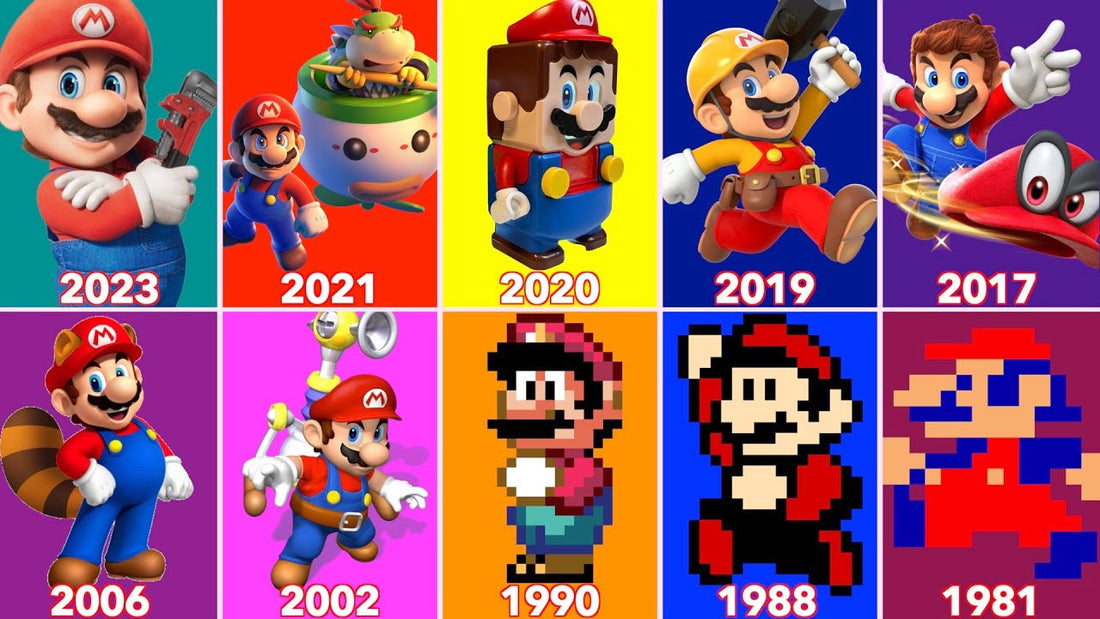
Mario's Transformations: A Timeline of the Most Famous Metamorphoses
Share
796 mots | Temps de lecture : 3 minute(s)
For over 35 years , Mario hasn't just been a bouncing plumber: he's a video game chameleon . Thanks to a multitude of transformations —costumes, items, powers—he's adapted his gameplay to a wide variety of worlds. From the Fire Flower to the Super Crown , from the cape to the elephant form, each generation of Nintendo consoles has brought its share of innovations. Here's a complete timeline of his most notable transformations.
1985 – Super Mario Bros. (NES)
- Super Mushroom : Makes Mario grow, allows him to take a hit
- Fire Flower : Allows Mario to throw flaming projectiles
Two iconic transformations from the first opus, laying the foundations for evolving gameplay through objects.
1988 – Super Mario Bros. 3
- Raccoon Costume : Glides and attacks with tail
- Tanuki Costume : Adds the invincible statue ability
- Frog Costume : Swims significantly better
- Brother Hammer Costume : Throws hammers
First game to offer a wide variety of costumes linked to specific mechanics.
1990 – Super Mario World
- Cape (Feather) : Allows you to fly and glide with precision
The cape quickly became a cult classic , offering unprecedented vertical freedom.
1996 – Super Mario 64
- Metal Cap : Invincibility, increased weight, underwater walking
- Winged Cap : Allows you to fly after a triple jump or cannon shot
Transformations completely change Mario's physics in an open world.
2006 – New Super Mario Bros.
- Mega Mushroom : Giant Mario, destroys everything
- Mini Mushroom : Tiny Mario, jumps higher, runs on water
The gameplay plays on scales , opening up new possibilities.
2007 – Super Mario Galaxy
- Bee Mario : Flies briefly, clings
- Boo Mario : Walks through walls, floats
- Spring Mario : Jumps very high, difficult to control
- Fire Mario (temporary)
The transformations here embrace gravity and the planets.
2009 – New Super Mario Bros. Wii
- Mario Penguin : Slide, swim, shoot ice balls
- Ice Flower : Freezes enemies and obstacles
Elemental powers specialize according to biomes.
2010 – Super Mario Galaxy 2
- Cloud Mario : Creates clouds to move through the air
- Mario Roche : Destructive Stone Ball
The new shapes strengthen the puzzle link between transformation and level design.
2012 – New Super Mario Bros. U
- Flying Squirrel Mario : hovers, clings to walls
Inspired by the cape and the raccoon: a perfect costume for verticality.
2013 – Super Mario 3D World
- Mario Cat : climbs, scratches, runs on all fours
Instantly cult transformation for its smooth handling.
2015 – Super Mario Maker
- Mystery Mushroom : 8-bit Mario transforms into various Nintendo heroes
Purely cosmetic transformation but loved for the fan service.
2017 – Super Mario Odyssey
Mario no longer uses fixed costumes; thanks to Cappy , he captures enemies and objects:
- T-Rex, Goomba, Bullet Bill, electricity, frog, etc.
Each capture changes the gameplay in radical and creative ways.
2023 – Super Mario Bros. Wonder
- Elephant Fruit : Massive Mario, powerful trunk, stores water
- Bubble Flower : Traps enemies in bouncing bubbles
- Flower Drill : allows you to dig into floors and ceilings
Recent transformations with experimental and humorous gameplay.
The most iconic transformations
- Fire Mario – the classic icon
- Mario Tanuki – synonymous with the NES era
- Mario Capé – a strong memory of the SNES
- Mario Cat – Adored Vertical Maneuverability
- Mario Elephant – a recent phenomenon that has already become a cult classic
- Cloud Mario – speedrunner favorite
Conclusion
Mario's transformations are more than just power-ups: they reflect Nintendo's boundless imagination . Generation after generation, they reinvent the way we approach levels, enemies, and exploration. From hero to acrobat , Mario can become a cat , a bee , or an elephant at will: a veritable open-air museum of gameplay .
